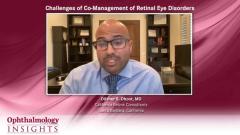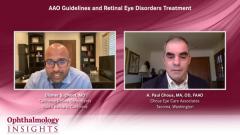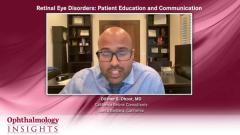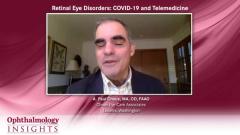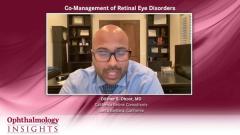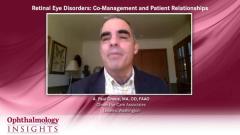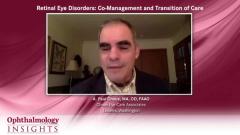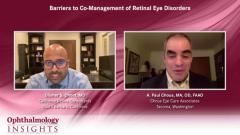
Co-Management of Retinal Eye Disorders
A. Paul Chous, MA, OD, FAAO, leads a discussion about the optimal circumstances for optometrists and ophthalmologists to work together to manage a patient with retinal eye disorders.
Episodes in this series

Dilsher S. Dhoot, MD: Can you describe the optimal circumstances under which optometrists [ODs] and ophthalmologists would work together to manage a patient with retinal eye disorders? What are the optimal circumstances, Paul?
A. Paul Chous, MA, OD, FAAO: That’s a broad question. It depends on having a relationship of mutual respect between the 2 providers and ODs who have the clinical acumen and the technology to make appropriate diagnoses. I’m encouraging my colleagues to have an OCT [optical coherence tomography] in their offices. Before I had an OCT, I thought I did a good job with diabetes. But you don’t realize what you’re not seeing until you start using it routinely. Use of technology is a big deal. Having bidirectional communication on an ongoing basis is a great idea. Having a relationship and knowing the treatment preferences of the retina specialists you’re working with is key.
I sent a patient in with severe NPDR [nonproliferative diabetic retinopathy]. The retina specialist elected not to use anti-VEGF. I talked about anti-VEGF with the patient as a way to possibly cause regression of their disease and lower the risk of vision-threatening complications, as we saw in the PANORAMA trial and even Protocol W. It’s important for us in optometry to have the conversation with you in retina specialty: what’s your practice philosophy? Is it patient dependent? Are you using anti-VEGFs more often for patients even in the absence of diabetic macular edema [DME] for treating patients with more severe nonproliferative disease? There’s an argument to be made for that. The studies say visual acuity outcomes aren’t better, but the other point is studies—clinical trials—are not the real world. A lot of patients don’t show up, and there’s an argument for many of these patients to get earlier treatment than they would have before. Am I off the rails on this?
Dilsher S. Dhoot, MD: No, you’re absolutely right. I’m a big believer in treating patients in a proactive fashion rather than reactive and waiting for DME or a vitreous hemorrhage event. The paradigm is shifting in patients with severe NPDR and level 47 (moderately severe NPDR) to 53 (severe NPDR), but a minority of retina specialists are treating them. Certainly, if a patient has had an event in their fellow eye and they have severe NPDR, it may prompt a retina specialist to start them early on anti-VEGF, but many well-sighted level 47 to 53 patients are out there. Sometimes it’s hard to get the buy-in for them to be treated, or the specialist doesn’t feel it’s time.
There are dueling groups of retina specialists when you go to the next Retina World Congress. The jury is still out on the outcomes and whether it’s necessary to treat these patients, but proactive treatment makes sense to me. You’re exactly right. In the most optimal circumstances, it’s good to know what camp your local retina specialist is in before you set up the expectation with the patient that they’re going to receive treatment. For the patient, that education is fantastic. It’s a great circumstance if the patient is even aware that’s an option for their eyes. That’s really fantastic.
It’s all about these patients who respect their optometrists’ judegemnt. They may have been seeing this optometrist for years. Having the optometrist weigh in on the treatment is sometimes very helpful, and you can get buy-in from the patient. The other items you mentioned regarding communication, which we touched on earlier as well, are super important in the optimal circumstance. Generally, it should be no judgment. If you find someone you jibe with, you’re working in a collaborative fashion to do what’s right for the patient based on the knowledge we have.
TRANSCRIPT EDITED FOR CLARITY
Newsletter
Don’t miss out—get Ophthalmology Times updates on the latest clinical advancements and expert interviews, straight to your inbox.


